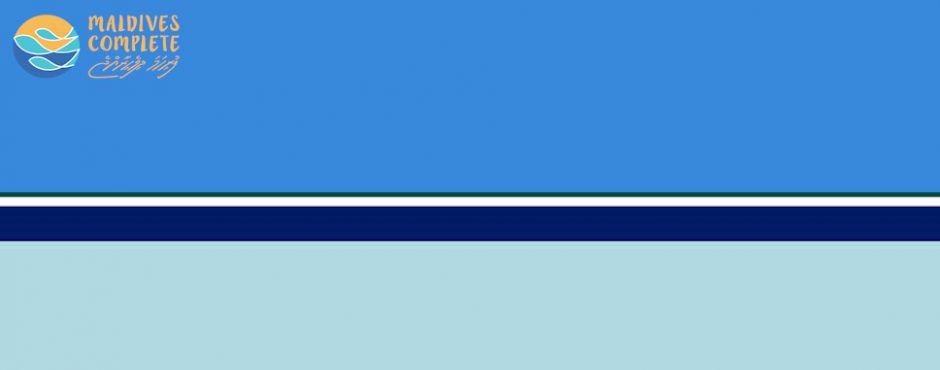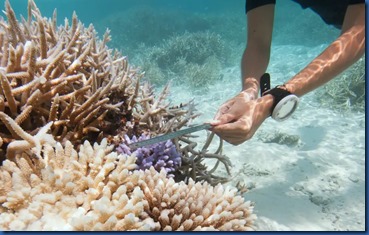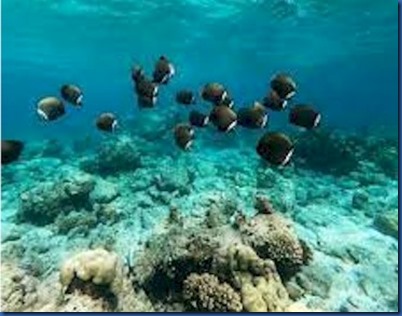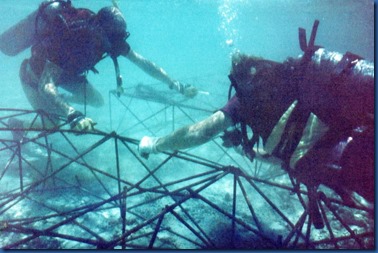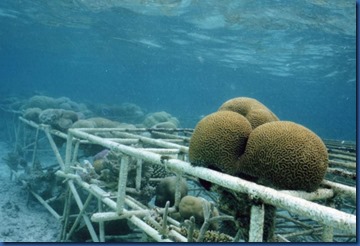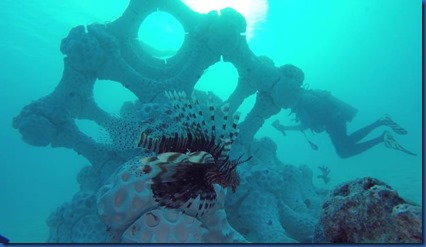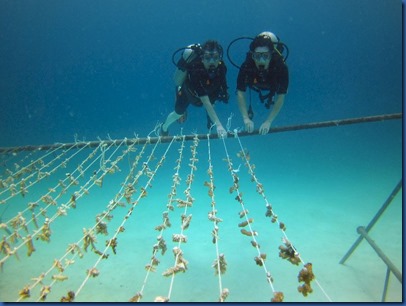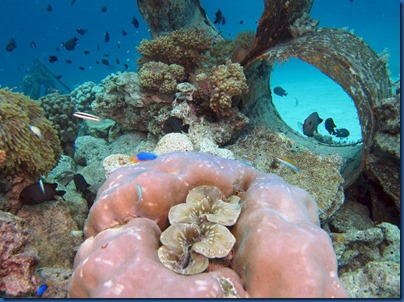The more challenges that climate change throws at the Maldives, the more create innovation it throws right back. The latest approach to coral regeneration is Nova’s depth-adjustable coral nursery. Developed by Nova Marine Biologist, Toby Corren with guidance from Dr. Inga Dehnert during the early stages, the depth of the line with the coral pieces are adjusted by shortening or lengthening the ropes attached to the horizontal propagation ropes which are anchored at the bottom with D-ring anchor points. The main objective of this depth flexibility is to help mitigate stress responses from increased sea surface temperatures in the upper water columns, especially during bleaching events. The project is currently focused on fast-growing scleractinian corals, but they plan to expand the nursery to include a broader range of species in the future.
Best of the Maldives: Coral Reef Gardener – Coco Palm Dhuni Kolhu
Mari-time, Mar-itime…How does your garden grow? With help from a lucky aquatic gardener at Coco Palm Dhuniu Kolhu. The resort is advertising for a “coral reef gardener” to work for a three placement:
- · “A lucky winner will be flown out to the luxurious Coco Palm Dhuni Kolhu resort in September, where they will help the Marine Educator with managing and fostering coral growth in the surrounding house reefs…applicants must submit a link to a 2-3-minute video and a 500-word cover letter explaining why they think they would be a good fit for the role. Applicants do not need to have previous experience, but they must be over the age of 18 years, be a competent open water swimmer and keen to gain experience in this field.”
Working in an octopus’ garden has 12 May deadline for application.
Best of the Maldives: Largest Coral Regeneration – Soneva Fushi
The big focus for Soneva Fushi’s marine biologists is big indeed…the world largest coral nursery:
- Partnership with Coralive and Ark2030 aims to propagate 50,000 coral fragments every year. Soneva has launched an ambitious programme to restore coral reef systems and create a coral hub for the Maldives. A partnership between the Soneva Foundation, the Swiss environmental organisation Coralive and the global ecosystem restoration organisation Ark2030, the project aims to protect and regenerate this vital marine habitat, which has been decimated by rising sea temperatures, ocean acidification, El Niño events and ocean pollution…’When finished, the coral farm at Soneva Fushi will be 1 hectare in size – one of the largest coral farms in the world – and in the ensuing years it is our goal to cultivate 1 hectare of coral each year at each of our resorts. This is the scale that is needed to have a meaningful impact and it also represents a huge opportunity for the Maldives to become a global leader in an activity that will likely have considerable future demand,’ said Sonu Shivdasani, CEO and Co-Founder of Soneva’.”
Best of the Maldives: Coral Reef Art – Sirru Fen Fushi
I rarely visit the same island twice (there’s just too much great stuff left to discover) much less write about the same feature twice. But islands get revamped and become entirely different properties which warrant taking an entirely fresh look. And the same is true with Sirru Fen Fushi’s “Corallarium” which started life as a surf-breaking art installation, but is now morphing into a reef regeneration project:
- “The Coralarium structure, and the sculptures within, act as an artificial reef, encouraging local marine life to make it a home. Up to 5m tall, each one of the soaring sculptures is constructed of more than 500 ceramic ‘starfish’ that have been specifically designed to attract a variety of fish and crustaceans – the hard shells catch and hold biomass, or ‘fish food’, which encourage coral larvae to attach and thrive, while nooks and dark cubbyholes in the structures provide a hiding place for a variety of fish and shellfish. Each sculpture is brought to life through its union with the life that attaches to it, transforming them from concrete to textured, living organisms.”
Great to see the second life to this installation giving the coral reef new life.
Best of the Maldives: Powered Reef Regeneration – Angsana Ihuru
The underwater versions of parrot fish and other reef marine life will have a literally more powerful habitat at Angsana Ihuru as a result of their “Necklace Project”. Hotelier Maldives published a great article about the project, “’The Necklace Project’ to be presented at the GM Forum in April”:
- “It is a steel structure 40 metres long and 4 metres wide, fixed inside the lagoon of Angsana Ihuru at a depth of 0.5 metres. Massive corals were initially put on top of the structure to stabilise it. The steel structures were provided with low voltage direct current which causes the growth of calcium carbonate, dissolved in seawater over the steel surfaces, which are completely protected from corrosion. The growing calcium carbonate on the steel structure, which has already achieved a thickness of about 20 cm in diameter in some places, now acts as a natural barrier to strong waves. The necklace has also become a haven for fish and other forms of marine life.”
Best of the Maldives: 3D Printed Reefs – Summer Island
Summer Island expanded its own tasting menu of artificial reefs with the world’s largest and Maldives first 3D printed reef. Maldives Independent reported:
- “The world’s largest and the Maldives first 3D-printed reef was installed by a resort at the weekend, with the technology being used to help protect coral reefs. The artificial reef, assembled with hundreds of ceramic and concrete modules, was submerged in seven metres of water in a part of the lagoon where Summer Island Maldives is building a new coral reef ecosystem…The project started in Australia, where industrial designer Alex Goad of Reef Design Lab used computing modelling to design reef structures similar to those found naturally in the Maldives. A 3D printer took 24 hours to print moulds which were then cast in ceramic, an inert substance similar to limestone rock, and shipped to the Maldives. They were filled with marine concrete on the resort’s beach before being taken into the lagoon and assembled. Like a giant aquatic LEGO set the 220 ceramic, concrete-filled moulds were slotted together underwater to create the new reef. Coral fragments, grown on the resort’s existing and extensive coral nursery, were transplanted onto the 3D reef. In a few years, when the corals have colonised the reef, the resort wants a new reef teeming with fish and other marine life. If the 3D printing technology proves successful, it could be a new way of helping coral reefs adapt to a warming climate.”
Best of the Maldives: Artificial Reefs – Summer Island
Earth Day today. Time to give back to the planet that gives us all so much. In the Maldives, probably the biggest initiative to strengthen the planet are the reef building initiatives to restore coral stressed by rising sea temperatures as well as outbreaks of COTS. Dozens of resorts invest in these reef regeneration projects, but I’ve never seen so many different approaches than Summer Island.
I’ve already written about their submerged Underwater Objects as well as their Coral Pops. They have also built a series of artificial reefs, the most recent being 15m x 2m x 4m constructed out of limestone rocks. Their latest innovation is a series of Coral Ropes. These serve as a coral nursery to incubate coral growth. Less than 2.5% die, and the ones that live are transplanted to the new artificial reefs:
- “Three pipes are completely winded in rope (needed over 500 meters) and 2 in fishing nets that were removed from the surrounding reefs. The plateau is hovering (we placed buoys inside the pipes) and it’s 6 meters long & 2 meters wide. The pipes are full of Durban dancing shrimps, Bruun’s cleaning partner shrimps and banded boxer shrimps. In between the ropes we already fixed a lot of coral fragments that are all alive AND growing ! Basically a home for a lot of life and we made it hovering so that if there were any crowns of thorns, the corals won’t be eaten by these damn creatures ! Underneath are limestone rocks where lion fish and octopii are hiding.”
Reef Madness!
Best of the Maldives: Coral Pops – Summer Island
Look For Circles Day today. Not too difficult in the Maldives which essentially is entirely comprised up of hundreds of of white trimmed green dots speckling the ocean. Even in its vibrant aquatic world, circles abound from massive platters of Table Coral to gently gliding Turtles. But Summer Island’s lagoon might be about the best place to celebrate today with their innovative reef generation project:
- “Diverland Maldives will deploy a CORAL POP, planted with 3-4 pieces of living coral fragments on the Summer Island’s house reef. These broken pieces of coral have been collected around reefs in the North Male Atoll. With the CORAL POPS we are building protection for aquatic life and protecting Summer Island’s beaches against erosion.”
The project evoked the expansive “Blood Swept Lands and Seas of Red” installation at the Tower of London. And at $5 a piece for guests to plant their own Coral Pops, Summer Island has set a new bar for affordable Reefscaping.
Best of the Maldives: Coral Lines – Gili Lankanfushi
Happy Australia Day, mate! While being only 12th in term of numbers of visitors to the Maldives, Australia is the 4th highest country in the fashionista database. Despite all its own sunshine and beach and even spectacular reefs (Great Barrier), the Maldives is still a distinctive beauty backdrop for the glitterati down under. Or maybe the depiction below of Australia’s own local offerings explains a bit of the exodus.
In honor of Australia Day today, I bring you something special from “down under”. In this case, under the sea with another reef regeneration initiative. Gili Lankanfushi’s coral lines project…
- “At Gili Lankanfushi resort in the Maldives, we are rehabilitating the coral reef by nursing coral on ropes (lines) (Levy et al., 2010) and later transplanting them onto degraded reef areas (Lindahl, 2003). Every rope is initially planted with 50 small, living coral fragments. We nurse the corals in the lagoon for 1 year and later transplant the ropes to the One Palm Island reef. Overtime we expect the corals get stronger, grow bigger and improve the health of the One Palm Island Reef. Our project is a research study on the subject of coral reef rehabilitation science, and 75% of the proceeds from every Coral Line donated will go to our Gili SEAS (Social & Environmental Awareness and Sustainability) fund, allowing our property to do more for the locals and more for the environment.”
Australia’s own reefs are suffering the stresses of the rise in ocean temperatures with extensive reports of bleaching. I expect Australia and the Maldives will eco-allies in preserving their distinctive ecological heritages with initiatives like Gili’s
Ripper!
Best of the Maldives Online: TED Coral Reefs
For those of you who can’t make even a brief stop over to the Maldives, but still wish to explore the wonders of its world famous coral reefs, I highly recommend Kristen Marhaver’s TED talk “How We’re Growing Baby Corals to Rebuild Reefs”…
“Coral reefs are farmers. They provide food, income and food security for hundreds of millions of people around the world. Coral reefs are security guards. The structures that they build protect our shorelines from storm surge and waves, and the biological systems that they house filter the water and make it safer for us to work and play. Coral reefs are chemists. The molecules that we’re discovering on coral reefs are increasingly important in the search for new antibiotics and new cancer drugs. And coral reefs are artists. The structures that they build are some of the most beautiful things on planet Earth. And this beauty is the foundation of the tourism industry in many countries with few or little other natural resources.”
Quite a few resorts now (17 by my count) invest in reef regeneration programmes on their island. Someday maybe Marhaver’s work will allow us to go beyond strapping coral pieces to frames and actually cultivate and propagate corals.
